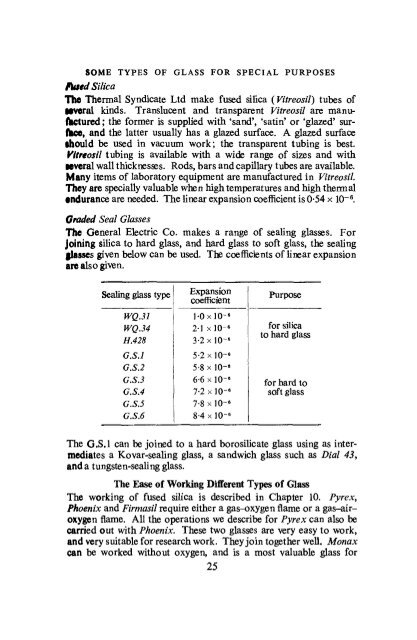Laboratory Glass-Working for Scientists - Sciencemadness Dot Org
Laboratory Glass-Working for Scientists - Sciencemadness Dot Org
Laboratory Glass-Working for Scientists - Sciencemadness Dot Org
You also want an ePaper? Increase the reach of your titles
YUMPU automatically turns print PDFs into web optimized ePapers that Google loves.
SOME TYPES OF GLASS FOR SPECIAL PURPOSES<br />
Fused Silica<br />
The Thermal Syndicate Ltd make fused silica (Vitreosil) tubes of<br />
Several kinds. Translucent and transparent Vitreosil are manufactured;<br />
the <strong>for</strong>mer is supplied with 'sand', 'satin' or 'glazed' surface,<br />
and the latter usually has a glazed surface. A glazed surface<br />
Should be used in vacuum work; the transparent tubing is best.<br />
Vitreosil tubing is available with a wide range of sizes and with<br />
leveral wall thicknesses. Rods, bars and capillary tubes are available.<br />
Many items of laboratory equipment are manufactured in Vitreosil.<br />
They are specially valuable when high temperatures and high thermal<br />
endurance are needed. The linear expansion coefficient is 0-54 x 10~* 6 .<br />
Graded Seal <strong>Glass</strong>es<br />
The General Electric Co. makes a range of sealing glasses. For<br />
joining silica to hard glass, and hard glass to soft glass, the sealing<br />
glasses given below can be used. The coefficients of linear expansion<br />
are also given.<br />
Sealing glass type<br />
WQ.31<br />
WQ.34<br />
HA28<br />
G.S.1<br />
G.S.2<br />
G.S3<br />
G.S.4<br />
G*S*5<br />
G.S.6<br />
Expansion<br />
coefficient<br />
l«0xl0-«<br />
2-1 xlO-*<br />
3-2 x 10 6<br />
5-2 x 10~ 6<br />
5-8 x 10-*<br />
6-6 x 10- 8<br />
7-2 x 10-*<br />
7-8 x 10~ 6<br />
8-4 x 10~ 6<br />
Purpose<br />
<strong>for</strong> silica<br />
to hard glass<br />
<strong>for</strong> hard to<br />
soft glass<br />
The G.S.1 can be joined to a hard borosilicate glass using as intermediates<br />
a Kovar-sealing glass, a sandwich glass such as Dial 43,<br />
and a tungsten-sealing glass.<br />
Hie Ease of <strong>Working</strong> Different Types of <strong>Glass</strong><br />
The working of fused silica is described in Chapter 10. Pyrex,<br />
Phoenix and Firmasil require either a gas-oxygen flame or a gas-airoxygen<br />
flame. All the operations we describe <strong>for</strong> Pyrex can also be<br />
carried out with Phoenix. These two glasses are very easy to work,<br />
and very suitable <strong>for</strong> research work. They join together well. Monax<br />
can be worked without oxygen, and is a most valuable glass <strong>for</strong><br />
25
















